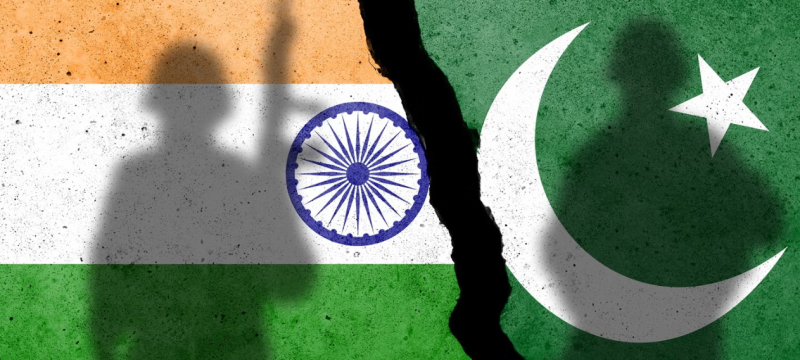On the night of May 6th, the Indian Air Force carried out multiple strikes inside mainland Pakistanand Azad Jammu and Kashmir (AJK), claiming to have targeted “terrorist infrastructure”. Pakistan’s military spokesperson confirmed the Indian strikes and stated that the strikes resulted in the deaths of 31civilians (including women and children) while causing injuries to 57. He further claimed that Pakistan shot down five Indian jets and a combat drone in the ensuing pre-dawn engagements.
On May 8th, Pakistan claimed to have neutralized India’s 29 HAROP long-range loitering munitions, on Suppression of Enemy Air Defenses (SEAD) missions, across major cities. India confirmed that it had mounted a drone attack on Pakistan and termed it a “response” to Pakistan’s drone and missile attack on Indian cities the previous night — a claim that Islamabad categorically denied and labelled the Indian account a “cooked-up story” aimed at falsely implicating Pakistan.
The Indian strikes came against the backdrop of an attack on tourists in picturesque Baisaran meadow in Jammu and Kashmir’s Pahalgam. The attack resulted in the deaths of 26 tourists and pushed the two countries towards a military standoff. The Indian air strikes are far bigger in magnitude, scope, and impact than the 2019 Balakot strike and crossed at least five new thresholds. Given Pakistan’s declaratory policy of Quid Pro Quo-Plus against limited Indian attacks, Pakistan’s inevitable retaliation would also likely be more forceful and devoid of any restraint. The ensuing high possibility of tit-for-tat exchanges entails the risks of India and Pakistan heading towards a wider military conflict remain exorbitantly high.
Indian Air Attacks Crossed At Least Five New Thresholds:
The first threshold that has been crossed by India is the targeting of a multitude of locations. Compared to the Balakot airstrike, which targeted only a single location, India claimed to have targeted nine sites in the recent strikes. Pakistan’s military spokesperson acknowledged Indian attacks on six locationswith 24 impacts, which spread from north in Muzaffarabad in AJK to the South in Bahawalpur in theprovince of Punjab. The targeting of the multitude of locations is a huge escalatory stride that India has taken.
The second threshold that has been crossed is the choice of targets surrounded by densely populated areas. While the Balakot site was a secluded place surrounded by forests with a low probability of collateral damage or civilian casualties, most of the sites targeted in the latest attacks are surrounded by densely populated areas with large-scale civilian casualties almost impossible to occur.
The third threshold that has been crossed is inflicting casualties. In 2016 and 2019, while India did not specify the number of casualties, Pakistan denied any loss of lives, which significantly helped in de-escalating the crisis. The recent attacks, however, crossed this most dangerous threshold and opened the door towards murky and treacherous waters of tit-for-tat attacks aimed at inflicting casualties, with the serious potential for large-scale escalation.
The fourth threshold that has been crossed is the depth of the Indian attacks. While India delivered ordnance in Balakot in 2019, located about 60 kms from the Line of Control (LoC), the depth of some of the recent strikes, especially those in Bahawalpur, about 100 kms inside mainland Pakistan, crosses the depth threshold of not engaging targets far away inside the international border.
The fifth threshold that has been crossed is targeting locations inside mainland Pakistan while crossing the international border. Although Balakot strikes did hit mainland Pakistan, Indian jets did not cross the international border, and Balakot’s location adjacent to the disputed Jammu and Kashmir enabled Pakistan to feel satisfied with retaliatory strikes on the Indian controlled side of the disputed Jammu and Kashmir. This may not be the case now, given Indian strikes violated the international border to hit at least four locations spread across Pakistan’s biggest Punjab province.
Pakistan’s Response: Not a Matter of Whether or Not, But How, When, and Where
Very similar to how Indian leadership found itself in a commitment trap following the Pahalgam attack to carry out strikes against Pakistan, the leadership in Islamabad and Rawalpindi also faces a commitment trap after it has made repeated public statements that any Indian aggression would meet a strong retribution. Moreover, as the new channels broadcast images of funerals of the dead civilians and debris of mosques and houses hit by Indian missiles, for Islamabad and Rawalpindi to back down withoutresponding in the promised befitting manner could entail tremendous reputational costs and thus remains very much a non-starter.
While Pakistan kept demanding evidence regarding the Pahalgam attack and made repeated calls for a neutral and independent probe, the Indian strikes set a dangerous precedent. New Delhi can now assume the role of the judge, jury, and executioner to pronounce any piece of territory inside Pakistan as “terrorist infrastructure” and declare any Pakistani citizen to be a “terrorist” and carry out military strikes. From Pakistan’s standpoint, this combination of hubris and intransigence on the part of India ought to be checked and thwarted at its very lowest, before it turns into a Frankenstein with lasting and far-reaching regional implications.
From a military standpoint, Pakistan simply cannot let its arch-rival India strike targets insidePakistan at will and then get away without any reprisal. This could set a dangerous new normal, dashingPakistan’s deterrence vis-à-vis India and implicitly making Pakistan acknowledge India’s military dominance—something that Islamabad has long resisted. Hence, for Pakistan to respond befittingly to Indian attacks is a military compulsion, which would not only prohibit any new normal from being established but would also ensure the credibility of Pakistan’s deterrence vis-à-vis India.
Probable Outlook of Pakistan’s Response:
Pakistan has stated on multiple occasions that it maintains a policy of Quid Pro Quo-Plus (QPQ-Plus) against limited Indian attacks, which entails that any limited strike would be responded to with equal ferocity plus a bit of extra. Given the unprecedented magnitude, scale, and impact of Indian attacks, which Pakistan has termed as an “act of war”, a QPQ-Plus response by Pakistan is all but inevitable, entailing targeting of several (most likely military) sites inside territories controlled by India.
Recently, Pakistan signaled that its policy of “restraint” vis-à-vis India is over, which essentially means removing any guardrails to Pakistan’s response to India’s military actions. Given that Indian strikes caused more than 26 casualties inside Pakistan, avoiding casualties—which was the major consideration during the 2019 Operation Swift Retort—is highly unlikely to apply this time around. To put it differently, a repeat of Swift Retort—just to display the will, resolve, and capability—is unlikely to be an attractive option for Pakistan time around.
Risk of Escalation into a Wider Conflict:
Pakistan faces strong political and military compulsions to forcefully respond to Indian attacks, andit is highly unlikely that Pakistan’s retributive military action would be aimed at avoiding casualties. In such a case, India is signaling that it is determined to maintain the escalation dominance by climbing on the third rung of the escalation ladder. The framing of the drone attack by India as a proportionate “response” to Pakistan’s attack can be interpreted as the message that any Pakistani response to the May 6th night attacks would evoke a strong response from India. New Delhi is essentially back to its playbook of manipulating the risk of escalation to deter a payback from Pakistan. Keeping in view that Pakistan cannot afford not to respond to Indian attacks and India signaling resolve to escalate further (which could just be a bluff), the chances of tit-for-tat exchanges spiraling into a wider military conflict between the two countries are exorbitantly high.
Off-Ramps and Chances of De-escalation:
India did get a chance to choose the off-ramp when Pakistan condemned the Pahalgam attack and called for an investigation into the attack. Currently, the ball is in Pakistan’s court, for whom to choose an off-ramp without QPQ-Plus retribution is politically and militarily unviable. However, if Pakistan can calibrate its response to only inflict proportionate damage, then probably India might have a chance to choose an off-ramp, but it would mainly depend on whether India—already facing huge embarrassmentfollowing the downing of its prized jets—can get a face-saving. While Pakistan offered such an off-ramp in 2019 by targeting open spaces, it may not be ready to offer one this time around. In any case, the India-Pakistan crisis has evolved into a highly risky game of chicken with an exorbitantly high risk of wider military conflict between the nuclear-armed neighbors.









